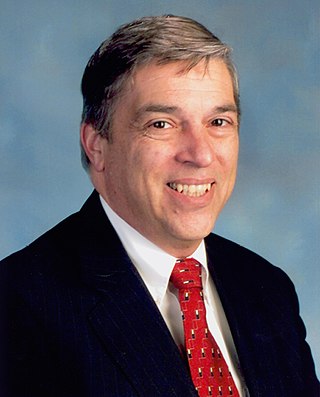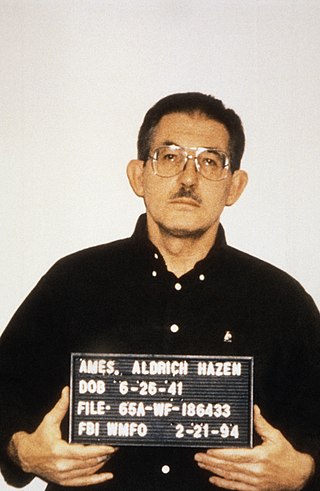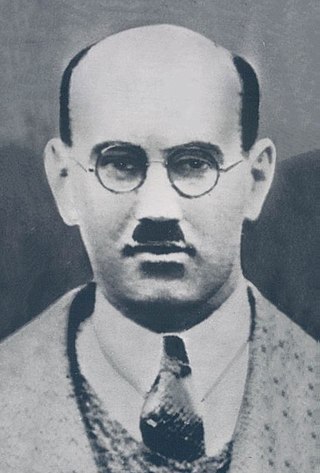Related Research Articles

Robert Philip Hanssen was an American Federal Bureau of Investigation (FBI) agent who spied for Soviet and Russian intelligence services against the United States from 1979 to 2001. His espionage was described by the Department of Justice as "possibly the worst intelligence disaster in U.S. history".

Aldrich Hazen Ames is an American former CIA counterintelligence officer who was convicted of espionage on behalf of the Soviet Union and Russia in 1994. He is serving a life sentence, without the possibility of parole, in the Federal Correctional Institution in Terre Haute, Indiana. Ames was known to have compromised more highly classified CIA assets than any other officer until Robert Hanssen, who was arrested seven years later in 2001.

Igor Sergeyevich Gouzenko was a cipher clerk for the Soviet embassy to Canada in Ottawa, Ontario, and a lieutenant of the Soviet Main Intelligence Directorate (GRU). He defected on September 5, 1945, three days after the end of World War II, with 109 documents on the USSR's espionage activities in the West. In response, Canada's Prime Minister, Mackenzie King, called a royal commission to investigate espionage in Canada.

Fred Rose was a Polish-Canadian politician and trade union organizer, best known for being the only member of the Canadian Parliament to ever be convicted of a charge related to spying for a foreign country. A member of the Communist Party of Canada and Labor-Progressive Party, he served as the MP for Cartier from 1943 to 1947. He was ousted from his seat after being found guilty of conspiring to steal weapons research for the Soviet Union.
Peter Maurice Wright CBE was a principal scientific officer for MI5, the British counter-intelligence agency. His book Spycatcher, written with Paul Greengrass, became an international bestseller with sales of over two million copies. Spycatcher was part memoir, part exposé detailing what Wright claimed were serious institutional failures he investigated within MI5. Wright is said to have been influenced in his counterespionage activity by James Jesus Angleton, counter-intelligence chief of the US Central Intelligence Agency (CIA) from 1954 to 1975.

Sir Roger Henry Hollis was a British intelligence officer who served with MI5 from 1938 to 1965. He was Director General of MI5 from 1956 to 1965.

William Leonard Higgitt was the 14th commissioner of the Royal Canadian Mounted Police (RCMP), holding office from 1969 to 1973, and President of the International Criminal Police Organization (Interpol) from 1972 to 1976. Leonard Higgitt's background in intelligence and counterintelligence with the RCMP during and after World War II made him the preferred choice as RCMP Commissioner at what was the height of the Cold War. Higgitt's tenure as Canada's top spy, first, and then as RCMP Commissioner, also coincided with the civil rights movement in the United States, which was part of a period of broader political unrest and social change in Canada, including the Quebec nationalist movement and first-ever diplomatic negotiations in Stockholm between Canada and Communist China. Higgitt's time as Commissioner was marked by his efforts to balance a traditional view of the Mounties in the eye of the public, and a trust in the RCMP attending that view, with more modern, high-tech, and legally complex policing methods, including surveillance and data-gathering practices that found the RCMP facing increasing media and judicial scrutiny.

Alan Nunn May was a British physicist and a confessed and convicted Soviet spy who supplied secrets of British and American atomic research to the Soviet Union during World War II.

The Embassy of Russia in Canada is the Russian embassy in Ottawa, Ontario, Canada, located at 285 Charlotte Street, at the eastern terminus of Laurier Avenue, built by W.E. Noffke. To the south it looks out on Strathcona Park while to the east it looks out on the Rideau River. Russia also maintains consulates in Toronto and Montreal.

The Gouzenko Affair was the name given to events in Canada surrounding the defection of Igor Gouzenko, a GRU cipher clerk stationed at the Soviet Embassy in Ottawa, from the Soviet Union in 1945 and his allegations regarding the existence of a Soviet spy ring of Canadian communists. Gouzenko's defection and revelations are considered by historians to have marked the beginning of the Cold War in Canada, as well as potentially setting the stage for the "Red Scare" of the 1950s.
The Security of Information Act, formerly known as the Official Secrets Act, is an Act of the Parliament of Canada that addresses national security concerns, including threats of espionage by foreign powers and terrorist groups, and the intimidation or coercion of ethnocultural communities in and against Canada.

Dmitri Fyodorovich Polyakov was a Major General in the Soviet GRU during the Cold War. According to former high-level KGB officer Sergey Kondrashev, Polyakov acted as a KGB disinformation agent at the FBI's New York City field office when he was posted at United Nations headquarters in 1962. Kondrashev's post-Cold War friend, former high-level CIA counterintelligence officer Tennent H. Bagley, says Polyakov "flipped" and started spying for the CIA when he was reposted to Rangoon, Moscow, and New Delhi. Polyakov was suddenly recalled to Moscow in 1980, arrested, tried, and finally executed in 1988.
Pyotr Semyonovich Popov was a colonel in the Soviet military intelligence apparatus (GRU). He was the first GRU officer to offer his services to the Central Intelligence Agency after World War II. Between 1953 and 1958, he provided the United States government with large amounts of information concerning military capabilities and espionage operations. He was codenamed ATTIC for most of his time with the CIA, and his case officer was George Kisevalter.
Jeffrey Paul Delisle is a former sub-lieutenant in the Royal Canadian Navy who passed sensitive information from the top-secret STONEGHOST intelligence sharing network to the Russian spy agency GRU. Delisle's actions have been described as "exceptionally grave" by Canada's Department of National Defence (DND) and "severe and irreparable" by the Canadian Security Intelligence Service.
Leslie James Bennett was a British/Canadian citizen who spent most of his working life as a counter-intelligence official, first for Britain's GCHQ, and later for the Royal Canadian Mounted Police (RCMP) Security Service. He took an early retirement and moved to Australia.
Sergeant Gilles G. Brunet was a career officer in Canada's Royal Canadian Mounted Police. He was born on September 20, 1934, in Rimouski. Commenced Saint Aloysisus School. He also attended A school at Côtes des Neiges and St-Nicolas School in Montreal. He attended D'Arcy McGee High School. He left school in June 1951. In Ottawa he continued school at Grade 13th at Nepean High school. In 1972 American suspicions had triggered one of Brunet's colleagues, Leslie James Bennett, to lose his security clearance, leading to his dismissal. A year after Brunet's death, a Soviet defector named Vitaly Sergeyevich Yurchenko would clear Bennett, and assert that Brunet was the mole.
Josaphat Brunet (1902-1974) was a senior police officer in Canada. In 1956 he was the founding director of the RCMP Security Service. In 1958 he was promoted to Deputy Commissioner of the Royal Canadian Mounted Police. Following his retirement from the RCMP he became, briefly, the director of Security for the National Bank of Canada. Later in 1960 he was appointed Director General of the Sûreté du Québec, a post he held for five years.
Emma Woikin was a Canadian civil servant who, in 1946, was convicted of spying on behalf of the Soviet Union. Woikin was one of the Canadians identified as spies by Igor Gouzenko when he defected from the Soviet Embassy in Ottawa in September 1945 in what became known as the Gouzenko Affair. Woikin was sentenced to two-and-a-half years at Kingston Penitentiary, becoming the first woman imprisoned for espionage in Canada.
David Gordon Lunan was a Canadian Army officer who, in 1946, was convicted of espionage on behalf of the Soviet Union. Lunan was identified as a spy by Igor Gouzenko when he defected from the Soviet Embassy in Ottawa in September 1945 and launched what became known as the Gouzenko Affair. Lunan had acted as a handler for three other accused spies: Israel Halperin, Edward Mazerall, and Durnford Smith. He was sentenced to five years' imprisonment and given two additional sentences totalling 15 months for contempt of court when he refused to testify against Halperin and Fred Rose.
References
- 1 2 Nigel West (2007). "Historical Dictionary of Cold War Counterintelligence". Scarecrow Press. pp. 99–100. ISBN 9780810864634 . Retrieved 2013-12-02.
Featherstone, Bower, Convicted of breaches of Canadian Official Secrets Act in 1966, and sentenced to 30 months imprisonment, Bower Featherstone was a civil servant who undertook minor tasks for his GRU handler, Eugen Kourianov. Soon after Featherstone came under surveillance by the RCMP, the GRU cut contact with him and Kourianov was recalled unexpectedly to Moscow, suggesting that the investigation, codenamed Gold Dust, had been compromised by a leak from inside the RCMP.
- 1 2 3 "Featherstone released after ten months". Ottawa Citizen. 1968-02-28. p. 46. Retrieved 2013-12-05.
- ↑ Reginald Whitaker; Gregory S. Kealey; Andrew Parnaby (2012). "Secret Service: Political Policing in Canada -- from the Fenians to Fortress America". University of Toronto Press. pp. 236–238, 240, 267, 306, 532. ISBN 9780802007520 . Retrieved 2013-12-02.
Brunet was marked for a brillian trajectory in the force. He joined the security service in the early 1960s. At the Russian desk, he won promotion in 1966 for investigative work that led to the conviction of Bower Featherstone.
- ↑ Nigel West (2007). Historical Dictionary of Cold War Counterintelligence. Scarecrow Press. pp. 42–43, 99–100. ISBN 9780810864634 . Retrieved 2013-12-02.
Convicted of breaches of Canadian Official Secrets Act in 1966, and sentenced to 30 months imprisonment, Bower Featherstone was a civil servant who undertook minor tasks for his GRU handler, Eugen Kourianov.
- ↑ "Gouzenko episode recalled". The Windsor Star. 1978-02-10. p. 8. Retrieved 2013-12-05.
RCMP testimony in a 1967 court case named Soviet attache Eugeni Kourianov as having met government mapmaker Bower Featherstone, then 28. Featherstone was sentenced to 30 months in jail, and served 10, for obtaining and retaining maps in violation of the Official Secrets Act -- the first under that law since the Gouzenko trials.